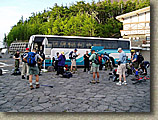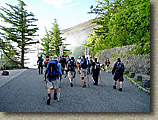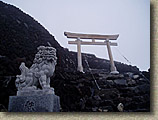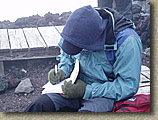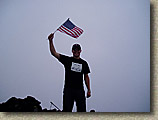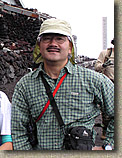Mount Fuji in Japan
The Video Second Trip Panoramic Shots
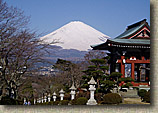
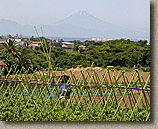 Climbing
Mt Fuji was something I had planned on doing since I first found out I would be
in Japan for the summer. It is a
once in a lifetime event for most people and I was not going to miss the
opportunity.The supported climbing
season for Fuji is July and August when the snow is clear and there are series
of huts operating along the climb to offer aid, food and shelter. Shortly after arriving in Japan in March, I found some
fellow mountain bikers and had been enjoying Japanese singletrack ever since. One of my riding regulars, Ken Morgan, came up with an awesome idea; lets
carry our bikes up Mt Fuji just before the main climbing season, and then ride
down! Crazy? Yeah, but what the heck, how often does one get a chance to mountain bike
down Fuji? (NOTE: Mountain Bikes are
not allowed on Fuji during July and August hiking season)
Climbing
Mt Fuji was something I had planned on doing since I first found out I would be
in Japan for the summer. It is a
once in a lifetime event for most people and I was not going to miss the
opportunity.The supported climbing
season for Fuji is July and August when the snow is clear and there are series
of huts operating along the climb to offer aid, food and shelter. Shortly after arriving in Japan in March, I found some
fellow mountain bikers and had been enjoying Japanese singletrack ever since. One of my riding regulars, Ken Morgan, came up with an awesome idea; lets
carry our bikes up Mt Fuji just before the main climbing season, and then ride
down! Crazy? Yeah, but what the heck, how often does one get a chance to mountain bike
down Fuji? (NOTE: Mountain Bikes are
not allowed on Fuji during July and August hiking season)
So the logistics of trying to do this started settling in. The climb to 12,388 feet was going to suck with a bike on my back. Even with my lightweight Intense Spider, I was sure
that I would be cussing at the bike before reaching the top. I thought of getting a frame pack and disassembling the bike
and strapping it to the pack, but I did not like the idea of riding down the
mountain with frame pack on. I decided to use my Camelbak Transalp, which is a very large cycling specific
pack. I went to a local outfitting
store and bought a handful of straps and figured out a way get the bike strapped
on.

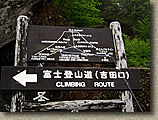 You can climb Mt Fuji via several routes; we would be going
up the Subaru line. The Subaru line
goes up the north side of the mountain and has separate ascending and descending
routes with the exception of the lower portion, which is common to both.
You can climb Mt Fuji via several routes; we would be going
up the Subaru line. The Subaru line
goes up the north side of the mountain and has separate ascending and descending
routes with the exception of the lower portion, which is common to both.
I was a little concerned about the
weather at 2AM on the morning of June 27th, 2004 when we headed out to Fuji as it was drizzling. As we drove up to the Kawaguchiko 5th station shortly before
5AM we climbed above the clouds and into beautiful weather. We were already at 7,700 feet and above the morning cloud layer. The 5th station is a actually a little village that has all of
the tourist accouterments as well as legitimate supplies someone may need. From
the 5th station we could see the peak that did not look that high at
all. I soon found out that
that was not Fuji’s peak we were looking at it, but merely a bump on the side
of the mountain.
After Ken and I got our stuff together, we took off
riding ahead of the hikers into the cool crisp morning air. The first part was a very wide gravelly walkway that was not steep at
all. We were soon riding along the misty edge of a cloud that rolled through the
trees. The cloud looked like a set of wispy fingers reaching out into our
path. It was quite surreal. We
only rode along this way for about a mile before the terrain became loose enough
that it was taking more energy to pedal than it was worth, especially
considering we knew we had along long way left to go yet. We were right along the timberline now at 8,000 feet and views of the
large expanse of clouds below us and the towering mountain above us came into
view. We started pushing our
bikes alongside of us and soon turned onto the ascending
route where the grade
became steeper. Soon we could
see the string of huts that are along the ascending route. The hiking was not too bad as it was mostly a smooth trail with
semi-loose mostly quarter sized or smaller lava rocks. The rocks varied in color from reddish rusty hues to dark brown tones. As we neared the 7th station at the Hanagoya Hut the trail
became more of a series of large lava rock steps. I put the nose of the saddle on my shoulder and hiked up to
the hut.
The huts offer a little shelter, a
place to buy expensive water and get your walking stick stamped or branded. Getting the stamps on your walking stick as you ascend Fuji is certainly
the tourist thing to do, but it makes a really nice souvenir.
I took a short rest here while soaking up the wonderful scenery. While doing this I noticed that just beyond the hut the trail got
somewhat nasty. There would be no
carrying the bike on my shoulder up the next section; it was time to strap on
the bike onto the backpack. It
took me about five minutes or so to get the bike strapped in. There was plenty of weight on the pack, between the
bike, video gear, water, food, knee/shin and elbow guards I probably had 50lbs
our so on my back. The
bike was
strapped with the front wheel lower that than the rear but the weight was distributed
evenly. I left the wheels on as I
wanted to keep the weight from being too far off my back. The setup was pretty stable but I soon found out there were several spots
which required me to step sideways to get the wheels to clear the rocks.
The views as I continued up were quite surreal. Sometimes the views of the puffy white cloud backs below me made me think
I was in a jet at 35,000 feet or so.
My pace kept ahead of Ken and when
I would take breaks it was taking him longer and longer to catch up. During some
of my longer rest periods I was starting to get a little stiff so I told Ken
that I needed to keep moving while I could and we would meet up at the top so
the rest of my climb would be on my own. From
here I kept plodding along.
Between the 7th and 8th
stations were some particularly difficult sections that required more climbing
and two handed scrabbling than hiking. The
awkwardness of the bike required some tricky maneuvers on more than a few
occasions to get over and between some of the larger rock formations. I eventually made my way up to the Fuji-San Hotel at the 8th
station. The term hotel is used loosely as it basically large
room with mats on the floor and a blanket. It was starting to get chilly and the wind started to bite a little so I
switched out of the short sleeve jersey for a long sleeve one.
The sky was darkening now and I
could not see the summit as thick clouds had settled in across the top.
My shoulders were pretty much on fire and my quads were hurting.
I was starting to not have any fun. I continued onward and upward where I found the thinning air had my heart
racing with even the easiest of steps. I
found that I had to take breaks much more often than before.
The trail did offer a break from the rock scrambling where I could simply
put one foot in front of the other up the volcanic ash and small lava rocks
covered trail.
The weather continued to
deteriorate as I climbed into the cloudbank. Visibility was down to less that 100 feet and the wind would occasionally
gust upwards to what I would guess was 25 to 30 mph. I was newly blown over on a couple of occasions.
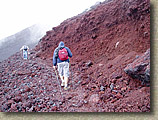
I eventually made it up to the
Goraikokan hut, the last shelter before the summit. Above here the trail turned back into a series of jumbled
rock scrambles that now had become quite a task to get up and over them. I felt
like Frodo Baggins trying to climb Mt Doom at this point. What was I thinking
when I decided to do this? That
downhill better be awesome. I was
in a one foot and hand placement at a time mode now. I was above 12,000 feet now and my heart was racing and my lungs struggled
to pull oxygen out of the thin air. I’m
sure some of my Colorado cycling friends would laugh at me for whining about a
little thin at this altitude, but if they were here now, I would let them carry
the bike for a while. I had to
take
breaks every few minutes now. My
shoulders were really hurting, but I dare not take off my pack, as it would only
feel worse to put it back on. I
certainly had my head in the clouds now as the visibility was 30 feet at most
and the wind was chilly and damp. I
wanted to put on my gloves, not so much to take the chill off of them, but
because they were becoming a little tender in spots from grabbing onto the rocks to
help get up the more difficult sections of the trail. But getting to my gloves would require taking off my pack, and I could
have nothing to do with that. I
soon passed through a the lower archway/gate. I
knew I was within several hundred feet of the summit now although I could not see
it. Before long I could make
out the facing lions and the arch that marked the entrance to the summit. I broke out the camcorder (which I had on
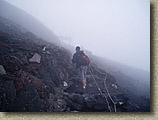 the waist belt of my pack,
meaning I did not have to take off the pack) to mark the moment and found some
new
the waist belt of my pack,
meaning I did not have to take off the pack) to mark the moment and found some
new energy as I passed between the lions and the gate. I had made it, although it was somewhat anticlimactic. I was by myself, it was cold, and visibility was now about 20 feet or so.
I walked on the wonderful flat ground between the huts while looking
for a somewhat sheltered spot to take the pack off and take a rest.
I then heard some voices out the fog saying they see a bike. Some of the hikers from our group where still on the top and
congratulated me on getting to the top.
Setting down the pack felt
awesome, my shoulders ached and my quads still burned but my entire body let out
a huge sigh of relief as the weight came off. I was starting to get cold now so I threw on my leg warmers, gloves, a
fleece pullover, and swapped out my ball cap for knit cap. I had made the climb
in 5 hours and 25 minutes. I found
out from our trip leader that Ken had his asthma act up on him so he would not
make it to the summit today. He
had cutover to the descending route at the 8th station and I would meet
me at the Edoya hut. The
original plan was for
Ken and I ride and video the trail that goes around Fuji’s crater. With the whiteout and Ken not on the summit I decided a solo trip around
the crater would not be worth it or wise.
After a few more pictures and congratulations from some Japanese folks I
was ready to head down. I strapped
on some protective gear, and fired up the helmet cam and proceeded down the
descending route.
The descending route is called
bulldozer road because a smallish bulldozer made it. It is a very long series of switchbacks that make there way
down the mountain. The
terrain here is mostly small lava rocks and volcanic ash. The trail is quite steep and the lava rocks make the riding seem like you
are descending a road covered six inches deep in marbles. The switchbacks were even worse as they were exceptional loose with deep
ash and crushed lava rocks. The
slightest twitch of the front wheel or more than a whisper of a feathering on
the brakes would cause your wheels to dig
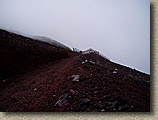 way down
which would most likely cause you to tip
over or put a foot down. These
switchbacks caused me to take a few "soil samples" on a couple of occasions. The upper part of the descending route was still in a
whiteout and to make matters worse my riding glasses were fogging up. I was particularly uncomfortable about not having glasses on so I put
them in "granny mode" (Pulled down on the nose a bit).
way down
which would most likely cause you to tip
over or put a foot down. These
switchbacks caused me to take a few "soil samples" on a couple of occasions. The upper part of the descending route was still in a
whiteout and to make matters worse my riding glasses were fogging up. I was particularly uncomfortable about not having glasses on so I put
them in "granny mode" (Pulled down on the nose a bit).
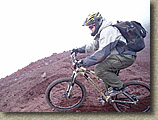
After a
couple of switchbacks I
somewhat figured them out and I soon was down to the Edoya hut where I rejoined Ken and we both continued on down the trail. The rest of the descent was full of steep straight-aways with marginal
control and extremely delicate braking into the switchbacks. During
part of the descent we dropped out on the clouds and regained some visibility. This was short lived as we soon descended back into another cloud layer
where the visibility was even worse than at the summit. The whiteout continued
until we were nearly back to the 5th Station where we suddenly rode out
of the clouds and rolled into the parking lot about a minute later. After a change of clothes we were ready for a well-earned celebratory
Japanese Beer.
|
A Special Thank You goes out to some of the folks who helped with photos for this page |
||
|
Drew Anderson |
Rafael Hernandez |
Tetsuya |
Other Pictures from the day
VIDEO
 This video was shot on June27th, 2004 just before the hiking season
opened. This video is a little different than most of my videos, somewhat
brooding in tone. Right
Click on the image to the left to download 121MB video that runs 8 1/2
minutes. There are a few pictures in here taken on my second climb
that show the views on clear days.
This video was shot on June27th, 2004 just before the hiking season
opened. This video is a little different than most of my videos, somewhat
brooding in tone. Right
Click on the image to the left to download 121MB video that runs 8 1/2
minutes. There are a few pictures in here taken on my second climb
that show the views on clear days.
Second Trip
Yeah Yeah I know only a fool climbs Fuji more than once. But it was well worth it. On July 17th I climbed Fuji for a second time. This time the climb was much easier without that bike thing strapped on my back so I may it up in 3 hours and 45 minutes. Of course the hike down took much longer at around one hour and 30 minutes. The sky was for the most part clear and the expansive views were truly incredible.
Shots taken at the "lower" elevations on the way up to the 8th
station
Views of the gates, through out Japan you will see entrances to shrines that
have two gates with facing lions between them. I have yet to do the
research their meaning, but it certainly feels great to pass through the last
one at the summit!
Views from the huts and shrine and the summit
Some of the views on the descent
Panoramic Shots
Here are some shots put together on my 17th of July trip on Fuji

Less than a mile into the hike here are your views.

About the 6th Station on the ascending route
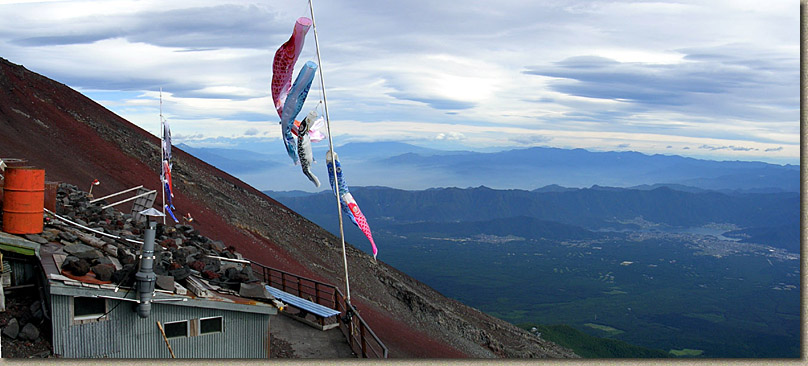
Still climbing, the grass is all gone.

